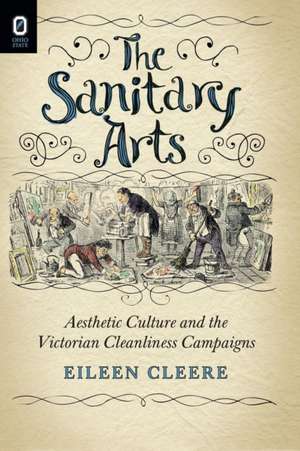The Sanitary Arts: Aesthetic Culture and the Victorian Cleanliness Campaigns
Autor Eileen Cleereen Limba Engleză Paperback – 31 mai 2016
Eileen Cleere argues in this interdisciplinary study that mid-century discoveries about hygiene and cleanliness not only influenced public health, civic planning, and medical practice but also powerfully reshaped the aesthetic values of the British middle class. By focusing on paintings, domestic architecture, and interior design, The Sanitary Arts: Aesthetic Culture and the Victorian Cleanliness Campaigns shows that the “sanitary aesthetic” significantly transformed the taste of the British public over the nineteenth century by equating robust health and cleanliness with new definitions of beauty and new experiences of aisthesis. Covering everything from connoisseurs to custodians, Cleere demonstrates that Victorian art critics, engineers, and architects—and even novelists from George Eliot to Charles Dickens, Charlotte Mary Young to Sarah Grand—all participated in a vital cultural debate over hygiene, cleanliness, and aesthetic enlightenment.
The Sanitary Arts covers the mid-forties controversy over cleaning the dirt from the pictures in the National Gallery, the debate over decorative “dust traps” in the overstuffed Victorian home, and the late-century proliferation of hygienic breeding principles as a program of aesthetic perfectibility, to demonstrate the unintentionally collaborative work of seemingly unrelated events and discourses. Bringing figures like Edwin Chadwick and John Ruskin into close conversation about the sanitary status of beauty in a variety of forms and environments, Cleere forcefully demonstrates that aesthetic development and scientific discovery can no longer be understood as separate or discrete forces of cultural change.
The Sanitary Arts covers the mid-forties controversy over cleaning the dirt from the pictures in the National Gallery, the debate over decorative “dust traps” in the overstuffed Victorian home, and the late-century proliferation of hygienic breeding principles as a program of aesthetic perfectibility, to demonstrate the unintentionally collaborative work of seemingly unrelated events and discourses. Bringing figures like Edwin Chadwick and John Ruskin into close conversation about the sanitary status of beauty in a variety of forms and environments, Cleere forcefully demonstrates that aesthetic development and scientific discovery can no longer be understood as separate or discrete forces of cultural change.
Preț: 259.41 lei
Nou
Puncte Express: 389
Preț estimativ în valută:
49.64€ • 51.96$ • 41.07£
49.64€ • 51.96$ • 41.07£
Carte tipărită la comandă
Livrare economică 02-08 aprilie
Preluare comenzi: 021 569.72.76
Specificații
ISBN-13: 9780814252789
ISBN-10: 0814252788
Pagini: 208
Dimensiuni: 152 x 229 x 15 mm
Greutate: 0.31 kg
Ediția:1
Editura: Ohio State University Press
Colecția Ohio State University Press
ISBN-10: 0814252788
Pagini: 208
Dimensiuni: 152 x 229 x 15 mm
Greutate: 0.31 kg
Ediția:1
Editura: Ohio State University Press
Colecția Ohio State University Press
Recenzii
“In The Sanitary Arts, Eileen Cleere offers a revisionary history of nineteenth-century aesthetic theory that brings aesthetics into dialogue with sanitary reform and eugenics. This exciting intervention will draw the interest of a wide-range of Victorian and modernist scholars. Cleere’s carefully-researched and well-argued work revisits and recasts thinkers with whom we are all familiar while at the same time introducing us to new writers and novels. This book is an impressive scholarly accomplishment.” —Barbara Leckie, Carleton University
“Theoretically informed and interdisciplinary in scope, The Sanitary Arts carefully examines a major shift in the cultural history of taste, illustrating how dominant models of beauty yielded to a Victorian aesthetic of cleanliness that relied on senses other than vision alone. Rethinking how cultural change occurs, Eileen Cleere establishes discursive and ideological connections among sanitation reform, medicine, science, art criticism, painting, and literature. Scholars in all these fields will greatly benefit from the concrete analyses this book provides.” —Linda M. Shires, David and Ruth Gottesman Professor of English, Yeshiva University
Notă biografică
Eileen Cleere is professor of English at Southwestern University, Georgetown, Texas.
Cuprins
Introduction––Foul Matter: Edwin Chadwick, John Ruskin, and Mid-Victorian Aesthesis
Chapter 1––Dirty Pictures: John Ruskin, Modern Painters, and the Victorian Sanitation of Fine Art
Chapter 2––The Sanitary Narrative: Victorian Reform Fiction and the Putrescence of the Picturesque
Chapter 3––Victorian Dust Traps
Chapter 4––The Surgical Arts: Aesthesia and Anaesthesia in Late-Victorian Medical Fiction
Chapter 5––Aesthetic Anachronisms: Mary Ward’s The Mating of Lydia and the Persistent Plot of Sanitary Fiction
Chapter 6––Intensive Culture: John Ruskin, Sarah Grand, and the Aesthetics of Eugenics
Coda––On Methods, Materials, and Meaning
Chapter 1––Dirty Pictures: John Ruskin, Modern Painters, and the Victorian Sanitation of Fine Art
Chapter 2––The Sanitary Narrative: Victorian Reform Fiction and the Putrescence of the Picturesque
Chapter 3––Victorian Dust Traps
Chapter 4––The Surgical Arts: Aesthesia and Anaesthesia in Late-Victorian Medical Fiction
Chapter 5––Aesthetic Anachronisms: Mary Ward’s The Mating of Lydia and the Persistent Plot of Sanitary Fiction
Chapter 6––Intensive Culture: John Ruskin, Sarah Grand, and the Aesthetics of Eugenics
Coda––On Methods, Materials, and Meaning
Descriere
Shows that the “sanitary aesthetic” significantly transformed the taste of the British public over the nineteenth century.











